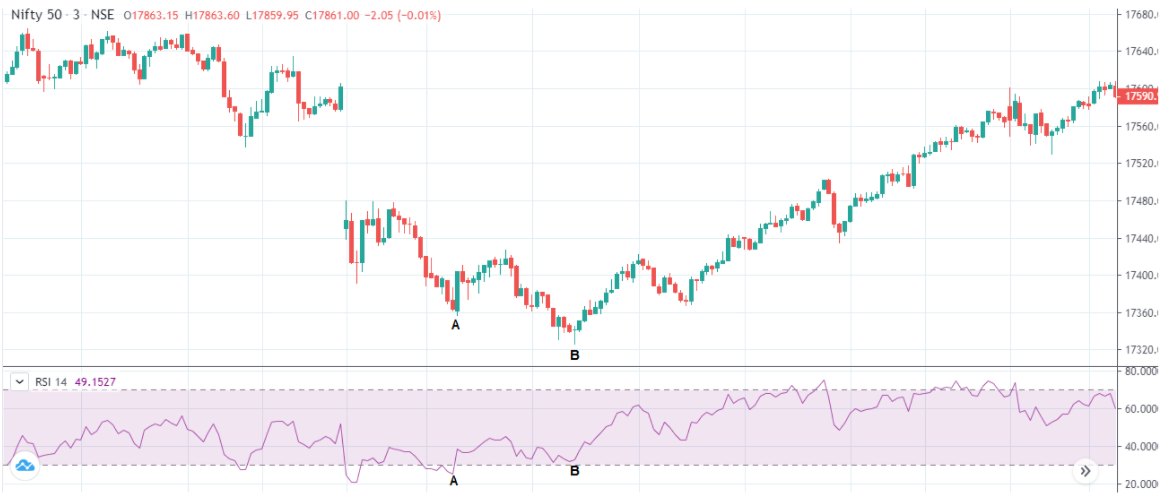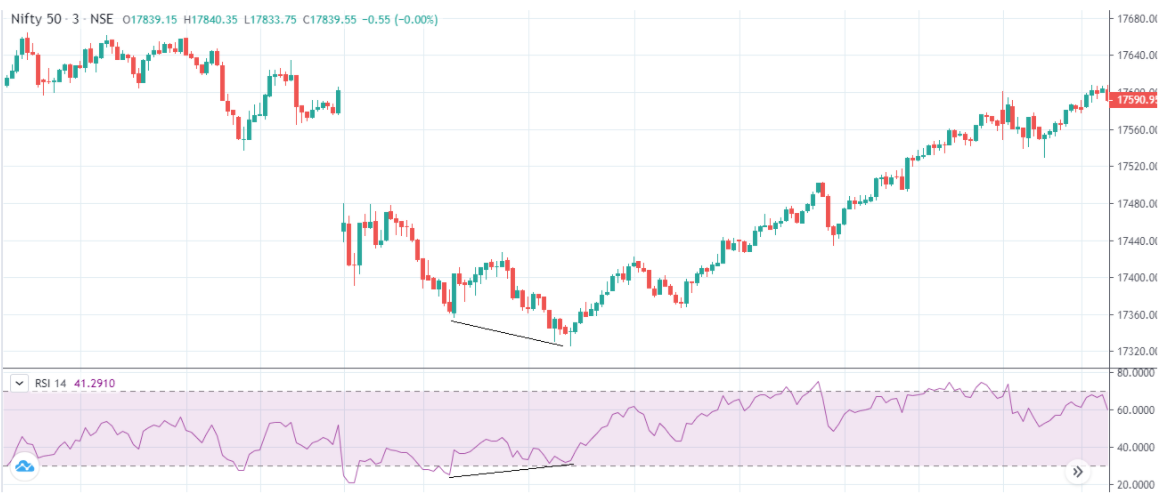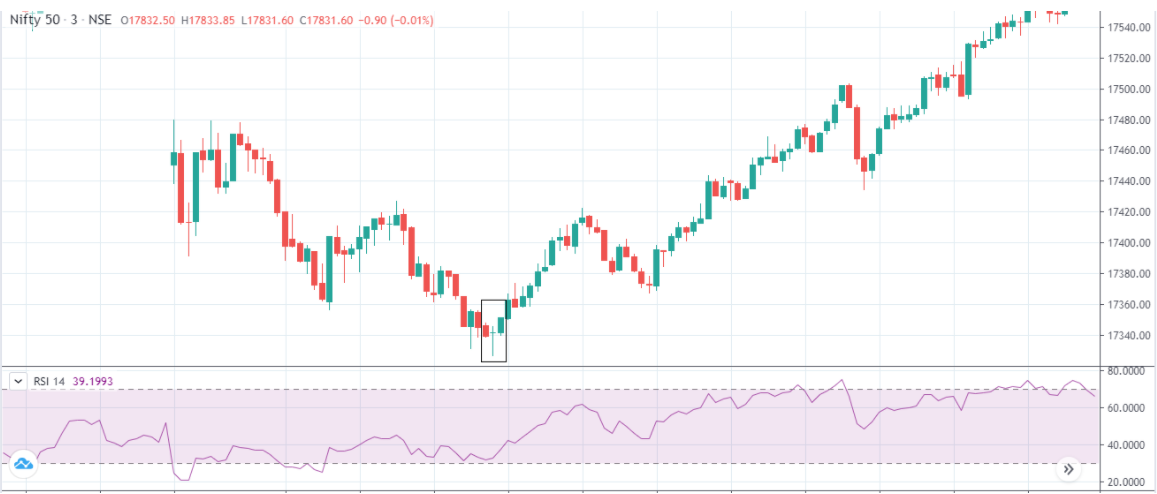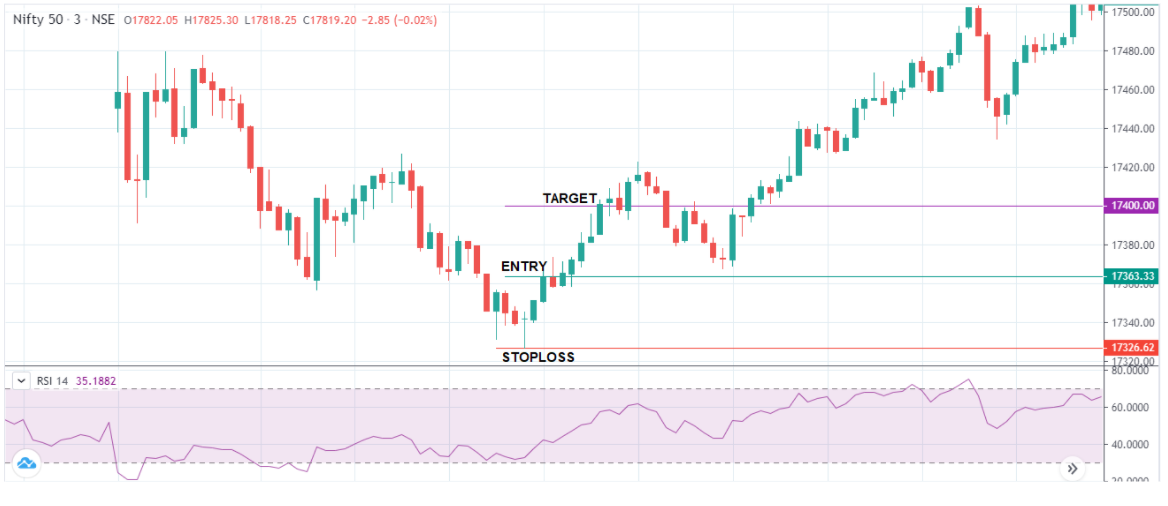RSI Positive Divergence Strategy in Intraday Trading & Technical Analysis

Here is a simple intraday trading setup based on the ** Relative Strength Index Indicator (RSI)** technique. The chart timeframe for this intraday strategy is 3 minutes.
Interestingly, you can use this setup to trade stocks, equity indices, commodities and or even currencies. Further, you can use any instrument to trade it i.e. cash (equity shares), futures or options. Also, with this strategy you can trade in a bullish as well as a bearish market.
We will use the RSI Divergence technique to look for a trend reversal and a candlestick pattern to confirm the trade setup. Hence this strategy is going to be a combination of both RSI Divergence and a candlestick pattern.
There are a couple of terms we need to know before we move to the rules of the strategy. Take a look at them below.
Swing low**-** This is a point where the price makes a low, takes a pause and bounces up from the low. So, the low point from where the price bounced back is called the swing low.
Positive divergence
- This is when price makes lower lows and RSI makes higher lows**,** thereby creating a divergence, a positive one.
Let’s understand the step-by-step process as to how to analyze and trade using this strategy. At the moment, let's look at a bullish or long-only setup.
Steps of the setup: To understand this strategy better, let’s analyse the Nifty spot chart in the example below.
Step 1 : We are looking for a positive trend reversal. We look for a positive RSI Divergence signal after a downtrend. The idea here is to enter at the start of a trend reversal at the bottom. We have to go to indicators and apply the ‘** Relative Strength Index RSI**’ indicator with default settings. The price should be making lower lows and the RSI should be making higher lows. Remember, we need to connect two low points of price and the corresponding two lows of RSI. Let’s understand this with the help of an example. We will look at a price chart on ** Upstox pro web**** platform.**

Look at the points A & B on the price chart. Those points are two swing low points. If we connect point A & B, we can clearly see the price is making lower lows (B point is lower than the A point)
Now, look at the corresponding A & B points on the RSI chart. Those are two swing low points on the RSI chart. Here, when we connect point A & B, we would see the RSI is making higher lows (B point is higher than the A point)

The price is in a downtrend and it is making lower lows. RSI here is indicating to us, in advance, that the current downtrend might take a pause and we might see a trend reversal here. This is called a positive RSI Divergence signal.
Step 2 : We have now got a possible RSI trend reversal signal. In order to confirm our analysis, we will have to hunt for a bullish candlestick pattern. We can just trade a divergence. The divergence needs to be supported by a price action confirmation, in our case

In the above chart, you could see a morning star candlestick pattern marked in a black box. It’s a three candle pattern and somewhat looks like a V shape pattern. The fourth candle after the three candle morning star pattern in green is the point where we can say that a new trend can possibly start here.
This confirms our analysis. Only after getting a RSI positive divergence signal and a bullish candlestick pattern, we will look to trade this setup. Now that the analysis and confirmation is done, let us see how we can trade the setup with a defined entry, exit and stop loss.
Step 3 : Let's understand with the help of a chart as to what price we enter, where do we keep our stop loss and when do we exit (target).
 You can see the GREEN line (17363.33) that's where we got the confirmation after the morning star pattern was formed. That is our entry point. We will enter at around those levels at 17363. Since Nifty spot can’t be traded, you can look to trade Nifty futures or options**.** If you choose to trade options, one way to go about it is that you can buy an ATM (at the money) strike price call option to trade. The market price is 17363 in our example and the nearest strike price seems to be 17350 call option. Since it’s an intraday trade, you choose weekly expiry rather than a monthly expiry contract.
You can see the GREEN line (17363.33) that's where we got the confirmation after the morning star pattern was formed. That is our entry point. We will enter at around those levels at 17363. Since Nifty spot can’t be traded, you can look to trade Nifty futures or options**.** If you choose to trade options, one way to go about it is that you can buy an ATM (at the money) strike price call option to trade. The market price is 17363 in our example and the nearest strike price seems to be 17350 call option. Since it’s an intraday trade, you choose weekly expiry rather than a monthly expiry contract.Now, let us consider stop loss. You can see the RED line (17326.62**)** which is the second swing low
- point B. That's 37 points below the entry point of 17363. If the Nifty doesn’t go up and with reversal hits 17326 (our stop loss), then we will take a small loss and exit our position.
Since it’s an intraday and a quick trade, the timeframe being 3 minutes, we will aim for a risk to reward of 1:1. In our example, the risk being 37 points, we will aim for a target of 37 points too from our entry price which comes to 17400 (17363+ 37)
You can see the PURPLE line (17400). Once our price hits 17400, we will exit our 17350 call option position.
We hope this trend reversal intraday RSI Divergence strategy was simple and easy to understand. You can try spotting it on charts and see if you are able to identify such setups.
We’ll come up with an article on how to use the same strategy to identify a bearish setup, a negative divergence strategy.
Until then, happy trading!